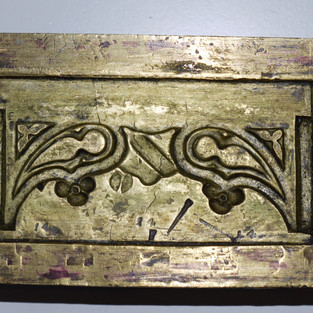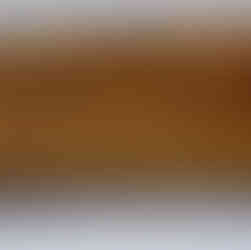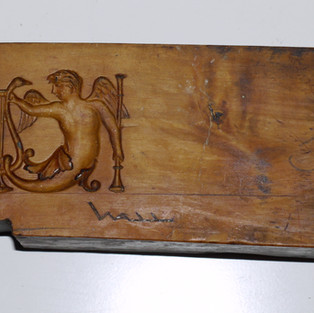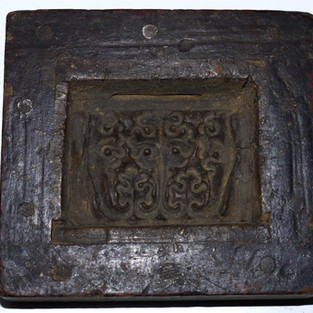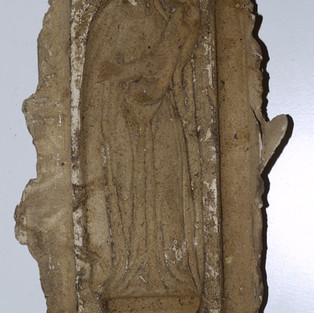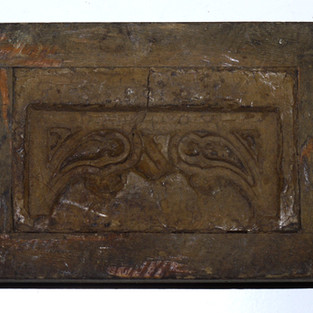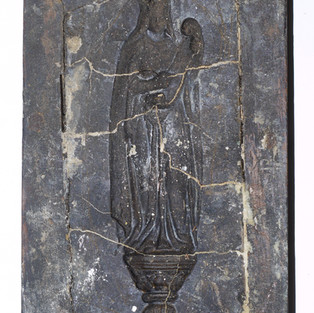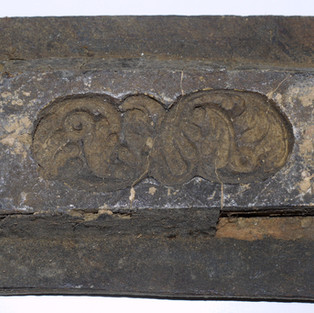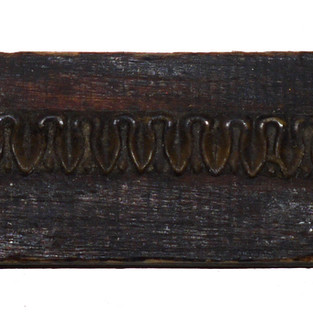The Erard and Morley decorative moulds
- Mike Baldwin
- Mar 9, 2019
- 7 min read
Updated: Mar 11, 2019
On 23 January 2014, in an auction at Dreweatts of Godalming, I bought a collection of composition moulds surviving from Erard and Morley harp companies. The associated catalogue describes them thus:
'27 in metal including two pairs of flying angels, a lyre in their outstretched hands, and a pair of smaller standing angels holding a harp and a trumpet; 19 in wood, the majority finely carved in boxwood, including a lion, a flying angel, a caryatid, two youths with a lyre and trumpets, and various ornamental pieces, some with the J.G. Morley stamp; and 34 for others formed of composite materials, some of the metal moulds set into larger wooden blocks, various sizes. *** some of the moulds were originally used at the Erard workshops. Two have their name, dates 1811 and 1823. Estimate £300 - £400 + fees.' (Lot 554, The Bibliophile Sale, Dreweatts, Godalming, 23 January 2014).
Also bought were the Morley harp company diaries and account journals, 36 volumes in all, dating 1891-1944.
'A series of 24 vol. recording charges made to clients, clients to whom instruments were hired or sold, restoration work on instruments, and letters and memos received, index to clients at the beginning, various bindings, 1891-1916; together with twelve accounts books and an address book from the same period. Estimate £250-£350.' (Lot 559, The Bibliophile Sale, Dreweatts, Godalming, 23 January 2014).
Together with instruments, paintings, drawings, letters, and harp accessories, these form the core of my private research collection. The Morley moulds, diaries and journals are perhaps the most comprehensive source of information on harp repairs, making, and sales in the late nineteenth and early twentieth centuries. I have started photographing each journal volume prior to deeper research; with around 380 pages per book (c13,680 pages in all), this will take some time, and will be written up at a later date (excerpts from some volumes can be seen here http://www.mike-baldwin.net/Documents.html). This blog post, discusses the moulds.
An important and rare survival from an early nineteenth century harp company, the moulds reveal much about the decoration of early nineteenth century instruments. Together, spanning 100 years of harp decoration, they mirror changes in design influence and materials, following trends in furniture and architecture throughout the nineteenth century. J. Geo. Morley acquired the moulds used by the English Erard company at an auction of the latter's harp business on 9 September 1890. Some were made by the George Jackson Company, others are anonymous. Of those made for the Morley company, some, marked with the name ‘Hall’, were used to repair early nineteenth century harps and new instruments made by the company. (The framing department of Tate Britain, London, also has a collection of reverse-carved composition moulds engraved 'Hall'). The origin of others is unknown.
Provenance
The moulds, having been acquired from the Erard company, were passed from J. Geo. Morley (1847 - 1922), to J. S. Morley (1897–1988), then to John Morley (b. 1932), a piano, harpsichord, and clavichord maker, now trading as Robert Morley Ltd., on the former’s retirement. When the harp and keyboard businesses were demerged in 1987, Clive Morley (1936-2015) took control of the harp business. In recent years, the moulds were loaned to the independent restorer, Michael Parfett, for the restoration, conservation, and repair of instruments on behalf of Morley’s, who, having ceased making harps, initially became a major importer of Russian and Japanese harps, and later American and Italian ones. The continued use of the moulds is perhaps responsible for their excellent condition. That they were regularly checked and oiled has helped to maintain them, and has kept the collection together.
The Morley family's long connection with the harp appears to start with the apprenticeship of various members, including J. Geo. Morley in the 1860s and 1870s. A letter on 28 October 1872 from A. Blondel, then director of the Erard company, to George Morley (presumably Joseph George Morley) accepting his resignation (archived on the Morley Harps website), cites the obligations of the latter's piano business as his reason for leaving. Addressed to Morley’s Pianoforte Warehouse, Clapham Common, London, the letter implies that his harp business was yet to open. Although some of the 60 or so Morley letters in my collection (1874-1920) are on J. Geo. Morley harps letter-headed paper, none of these predate 1891. The Morley harp ledgers start in 1891, four months after J. G. bought the stock and goodwill of the Erard company. It is therefore likely that this marks the opening of their harp business,
The Moulds
The 95 moulds can be divided into seven groups. The earliest four (c1805) are reverse-carved in boxwood and inset in another unidentified timber, probably originating from the Erat company (a lion mould matches casts on early Erat single actions). Of those made for Erard, twelve (c1810) for the Grecian harp, are cast in brass-alloy and embedded in wood, and ten for the Gothic (c1830) are in brass-alloy. There are three in steel, their dates and origins unknown, though two correspond to the winged lions of the Gothic, and one to the beaded chaplets of the Grecian. Of those used by the Morleys, there are sixteen in boxwood (c1890), eight for the Grecian, and eight for Morley-made harps, (c1900) and 48 in compo (first half of the 20thCentury) in rough wooden frames, mostly relating to the Gothic.
Composition makers, sometimes described in trade directories as frame makers, also manufactured architectural decorations. Martin (1813) writes:
There is a species of plastering practised in the trade and known to the public as Composition, Composition Ornament. This is done by all kinds of ornaments, not only for pictures, glass frames, &c. &c. The composition for this work is of a brownish colour exceedingly compact, and when completely dry very strong. It is composed of powdered whiting, glue in solution, and linseed oil.
In 1810, Érard chose one such craftsman, George Jackson, to decorate the first 50 of his new double-action instruments, paying -/24/- per harp. Jackson, whose father, Thomas is credited with composition’s invention, reputedly in conjunction with Robert Adam (1728-1792), made decoration for other harp makers such as Thomas Dodd and Alexander Barry. V&A. Archive of Art and Design, AAD/2012/1/2/1, George Jackson’s Accounts (1812-1818).
Designs for composition moulds were first modelled in clay from which the cameo or mould was carved in boxwood.
The carving the cameo is done with great neatness and truth, as on it depends the exquisiteness of the ornament that is to be cast in it. ‘Composition Ornament Making’, The Magazine of Science and School of Arts, 2 (London: Brittain, 1816), p. 271.
The mould maker planed and smoothed the timber block before marking out the design. It was then oiled before cutting with fine, sharp gouges, some as narrow as one-twentieth of an inch. The maker could copy an existing mould or judge how deep to carve the mould guided by eye. To make one in brass, copper, pewter, lead, or sulphur, a plaster or composition model was made and the mould was cast from it. Brass ones, made in this way, could be further carved or scratched to add fine detail. The 1824 Erat inventory notes three brass moulds, valued at £3 (20/- each), and eight wooden ones at 10/- each. Used in combination, these represent a small range of those required to decorate Erat’sharps. Erat purchased composition ornaments, including long lengths of ‘bottom moulding’ (-/3 per foot), ‘small strap’ (-/1 per foot), and ‘pine ovolo’ (-/2 per foot), from W. H. Freeman. Occasional purchases include a ‘set [mirrored pair] of seahorses’ (-/3/6) and a ‘rams head’ (-/6), which were common on English single-action harps. That caryatids, acanthus flowers and leaves, and cherubs with lyres, copied by Erat from Érard, are absent from the record suggests that they were made in their workshop.
By the second decade of the nineteenth century, composition ornament makers were well established in London. Each would likely have had their own recipes. Adding different ingredients in particular quantities changed the properties of the combo, making softer or harder, extending or shortening working time. Martin (1813) give a recipe and describes how it was made:
[…] to two pounds of whiting and one pound of glue, half a pound of oil is added. These are placed in a copper and heated, stirring it with a spatula till the whole becomes incorporated. It is then suffered to cool and settle; after which it is taken and laid upon a stone covered with powdered whitening and beaten till it becomes of a tough and of a firm consistence. It is then put for use, covered by wetted cloths to keep it as it is called fresh […] The composition is then cut with a knife into pieces adapted to fill the mould, and is closely pressed by hand into every part; it is then carried and placed in a press worked by an iron screw, and by which it is further pressed till it is supposed to be forced into every part of the sculpture of the cameo: after which it is taken out of the press, and by giving it a tap upside down only it comes easily away and out of the mould. Thomas Martin, The Circle of the Mechanical Arts(London: Richard Rees, 1813), p. 491.
Although it is plausible that some harp makers undertook some or all of this role, it is more likely that they relied on specialists. Gill (1823) writes:
If it be necessary to embellish the frames, or other work to be gilt, with composition ornaments, they made be had in London, soft from the press; and can be out on, after the smoothing, with a little hot thick whitening, or weak glue. What is squeezed out round their edges, in pressing them close, may be taken off with a brush and cold water: they must then have a coat of thin white, to remove any grease, and be finished like the rest of the work. The composition ornaments may also be put on oil-gold work, that is not to stand the weather, but does not then require the thin white: they must be finished in the manner of oil gilding. Composition ornaments are easily moistened, when dry, by wrapping them in a wet linen cloth, for twenty-four hours […]. The best plasterer in this line was the late Mr Thorp of Princes-street, St Anns; and the work appears now to be equally well performed by his successor Freeman. The Technical repository, ed. by T Gill, vol. 3 (London: Cadell, 1823), p.212.
The move from carved ornaments to those of composition was evidently motivated by cost: compo ornaments were quicker to make and easier to reproduce removing the need for a long and laborious stage of harp decoration. Gill writes, ‘It [composition] is at least 80 per cent cheaper than carving, and in many cases equally well calculated to answer every purpose to be derived from it.
A longer and more detailed article about harp decoration and the Erard and Morley moulds will follow in due course.
Update: 10 March 2019. The complete collection of Erard and Morley moulds are shown below.
Boxwood moulds (c1805), possibly from Erat
Brass alloy mould inset in wood, for Erard Grecian harp, c1810
Brass alloy mould for Erard's Gothic harp, c1830
Metal moulds, date unknown
Boxwood moulds for the Grecian harp, made for J. Geo. Morley, c1890
Boxwood moulds for harps by J. Geo. Morley, c1900
Moulds in composition by the J. Geo. Morley harp company, c1900









































